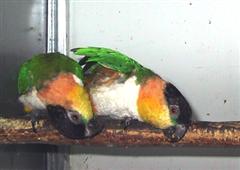Caique - Black Head
Black Headed Caique Scientific Name: Pionites melanocephala
Sun, 6th July, 2025 - 4:16 am GMT
Sponsor Ads:

Alternative Name
Black Headed Caique Scientific Name: Pionites melanocephalaBasic Info
Growing to about nine inches in length, Black-headed Caiques have predominantly green plumage. They are extremely colorful little birds with black crowns, napes, and foreheads. Their bill is also blackish, and the periopthalmic ring is dark gray like the feet. The iris is red. Black-headed Caiques have orange cheeks, throats, thighs and flanks. Their undersides are a creamy white color, and the undersides of their tails are yellow-orange and olive yellow. Black-headed Caiques' primaries and primary coverts are a deep violet or purple-blue color, and the upper sides of their tails have feathers tipped in yellow.
Health
If Black-headed Caiques are kept in a cage, they will need lots of exercise and playtime- getting a playpen is suggested! Be sure your bird has many toys and perches in his cage to keep him amused. The minimum size cage for one Caique is 24 X 24 X 24, the average size of Amazon-sized cages. A better choice would be the Cockatoo-sized cages, usually 36" long X 24" deep X 36" high. The bar spacing should be no larger than 3/4". The cage must be long and tall enough to fit several perches, a variety of toys, swings and vines. A Caique will use every square inch of the largest cage. Black-headed Caiques do very well on a basic pellet food supplemented with lots of fresh fruits and vegetables along with grain and sprouted seeds. They eat fruits, berries, and seeds, even fighting with each other over the seeds. They love to play and bathe, and need many leafy green branches for chewing. No matter how tame, docile, or affectionate your Black-headed Caique is, it is always capable of biting severely. Aggressive behavior in Caiques seems to stem from fear. Still postures, staring, and cheek puffing are all signs that your Black-headed Caique may be about to attack. Many Caiques react badly to strangers and may be very territorial. Be sure to teach your Black-headed Caique "up" as a command to come out of its cage, because allowed to come out of the cage by itself, Caiques are encouraged to develop territorial behavior. To prevent boredom, your Black-headed Caique needs a variety of toys. Breeding A Black-headed Caique's gestation period lasts about 27 days and the clutch consists of two to four eggs. The male Caique provides food for the female, who does the entire sitting. Young Black-headed Caiques have most of their feathers and can see by six and a half weeks of age. They generally remain in the nest for about two months. Immature Black-headed Caiques have horn colored bills, which spring from blackish bases, duller plumage than adults, and very dark irises.Habitat
Resides in tropical savannahs and forestsBehavior
If you have plenty of time and energy to devote to a pet, the Black-headed Caique may be right for you! These playful little birds are among the most beautiful of the parrot family and if you can devote enough of your time to a Caique, you will be well rewarded. In the wild, Black-headed Caiques spend most of their time up in the tree tops and love to play with twigs! They eat fruits, berries, and seeds, even fighting with each other over the seeds. They live in flocks, which upon perceived danger, become extremely still before rising into the air in a confusing show of cacophonous noise and flying feathers! Black-headed Caiques seem to have an endless energy supply and personalities, which are best described as "manic"! They love to play and bathe, and need lots of leafy green branches for chewing. Black-headed Caiques are extremely sociable even though their talking ability is quite limited. If they are kept in a cage they will need lots of exercise and playtime- getting a playpen is suggested! Caiques can be surprisingly aggressive and fearless among other birds, and they will often approach much larger birds. They are really not "6' 5" and bullet-proof" as their demeanor might suggest, and they must be constantly supervised when in the company of larger birds. Their exceptional playfulness begs for a partner, and for those not interested in breeding, two females can do quite well together. A particularly amusing behavior is their habit of hopping rather rapidly across almost any surface, which gives them the look of a wind-up toy. Be sure your bird has many toys and perches in its cage to keep it amused. The minimum size cage for one Caique is 24 X 24 X 24, the average size of Amazon-sized cages. A better choice would be the Cockatoo-sized cages, usually 36" long X 24" deep X 36" high. The bar spacing should be no larger than 3/4". The cage must be long and tall enough to fit several perches, a variety of toys, swings and vines. A Caique will use every square inch of the largest cage. Black-headed Caiques do very well on a basic pellet food supplemented with lots of fresh fruits and vegetables along with grain and sprouted seeds. Although Black-headed Caiques have lots of positive energy, sometimes they can be grumpy and nippy. Caiques need a strong hand to establish dominance because they can become aggressive if handled timidly. When raised correctly and handled firmly, Black-headed Caiques are fun friends! They are very intelligent and can learn a variety of tricks! They especially love to show off, and posture by strutting about importantly to establish their dominance. Caiques are also very affectionate and cuddly birds. Most love being petted and snuggled. The average adult will live between 25 and 40 years.Origin
ColumbiaHistory
Black-headed Caiques are native to Columbia, Ecuador, Venezuela, the Guyanas, Brazil, and parts of Peru, where it resides in tropical savannahs and forests. First recorded by Linné in 1758, Black-headed Caiques are popular as pets but should only be kept by those who can be patient but firm with them.Common Foods
N/ASponsor Ads:
Next to a circus there ain't nothing that packs up and tears out any quicker than the Christmas spirit. --Kin Hubbard--
Caique - Black Head
Coded by: BGID® | ALL RIGHTS RESERVED Copyright © 2000-2025
Disclaimer | Privacy | Report Errors / Contact | Credits








 President of the United States of America - Real Estate mogul, Pageant owner and now one of the most controversial men in political history.
President of the United States of America - Real Estate mogul, Pageant owner and now one of the most controversial men in political history.  Global warming has been in and out as the "latest" hot topic for many years. It is, according to modern scientists, the result of man-made industrial pollutants, clearing forested areas, agriculture, etc. But now they are thinking it started way before the Industrial Revolution...
Global warming has been in and out as the "latest" hot topic for many years. It is, according to modern scientists, the result of man-made industrial pollutants, clearing forested areas, agriculture, etc. But now they are thinking it started way before the Industrial Revolution...  Politician, US Vice President and President of the USA - Joseph Robinette Biden Jr.
Politician, US Vice President and President of the USA - Joseph Robinette Biden Jr.  versus
versus  Russia: 'The Evil Empire'? Are they all that bad or is it just the USA trying to portray Russia as bad because they are a world power with land bigger and a society very different from the USA ideal?
Russia: 'The Evil Empire'? Are they all that bad or is it just the USA trying to portray Russia as bad because they are a world power with land bigger and a society very different from the USA ideal? 
 Corona virus
Corona virus 
 Users with wide screen monitors can benefit from more content on every page.
Users with wide screen monitors can benefit from more content on every page.